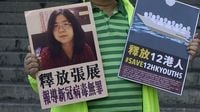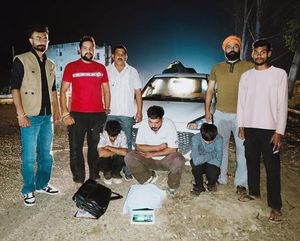In Kathmandu, Nepal, the recent surge in violence and government crackdowns has cast a long shadow over the region’s already fragile press freedom. The city was shaken in September 2025 by violent protests, triggered in part by the government’s abrupt ban of 26 social media sites for allegedly failing to comply with registration requirements. The ban, which was lifted only days later, became a lightning rod for public anger, fueling demonstrations that left dozens dead and government offices in flames. As reported by Global Press Journal, the immediate aftermath saw Prime Minister KP Sharma Oli step down, making way for Sushila Karki’s appointment amid mounting calls for accountability and reform.
Yet, the unrest in Nepal is just one chapter in a broader, troubling narrative playing out across Asia. According to an analysis by NPR, detentions of journalists and media workers in the Asia-Pacific region have soared, rising from 69 in 2010 to a staggering 334 in 2022, before settling at 300 in 2024. China stands out as the world’s leading jailer of journalists, with 112 behind bars, while Hong Kong, once a beacon of press freedom, now counts eight journalists imprisoned following Beijing’s imposition of a national security law in 2020. Myanmar, too, has become a hotspot for journalist detentions, with 51 currently incarcerated after the 2021 coup and ensuing civil war.
In Nepal, the government’s use of legal tools to silence dissent has become a flashpoint. In June 2025, the Kathmandu District Court issued a warrant for the arrest of journalist Dil Bhusan Pathak, host of the popular YouTube show “Tough Talk.” Pathak had questioned the involvement of Jaiveer Singh Deuba, son of a former prime minister, in the controversial purchase of the Hilton Hotel in Kathmandu—a building torched during the recent protests. Charged under Nepal’s Electronic Transactions Act with spreading hate and jealousy, Pathak’s case was ultimately deemed by the High Court to fall under the Press Council Nepal’s authority, not the criminal courts. Nevertheless, police persisted in their attempts to detain him, raising alarms among press freedom watchdogs.
“There is a big difference between the law related to cybercrime and media laws,” constitutional expert Bhimarjun Acharaya told Global Press Journal. “When a journalist makes a comment in their capacity as a journalist, media laws and not cybercrime laws should apply.”
Authorities, meanwhile, deny any misuse of the law. “No journalist should be punished for writing news against the government or ministers,” said Prithivi Subba Gurung, a former government spokesperson. Yet, he added, “it’s also the government’s responsibility to ensure that their work doesn’t promote national division or harm social harmony.”
Such justifications have done little to quell concerns. In early June 2025, the Kathmandu District Court ordered two online publications—Bizmandu and Nepal Khabar—to delete stories alleging that Santosh Narayan Shrestha, chairperson of the Securities Board, had demanded kickbacks for approving infrastructure projects. The court later dismissed the case, but not before press freedom groups like the Federation of Nepali Journalists and the International Federation of Journalists protested the order as a violation of constitutional protections.
Statistics paint a bleak picture. From May 2024 to April 2025, the Federation of Nepali Journalists recorded 73 press freedom violations, up from 62 the previous year and 55 the year before that. Freedom Forum data cited by Global Press Journal shows that in 2024, security officials were responsible for 35 violations against the media, political cadres for 26, and government employees for eight. In 2025 so far, government officials have accounted for 34 violations, political actors for 18, and security officials for 14. While these numbers are lower than the peaks recorded between 2017 and 2022, the trend remains deeply troubling.
Sadly, violence against journalists is not new in Nepal. Between 2002 and 2018, 38 journalists were killed, according to the Federation of Nepali Journalists. The dangers remain acute: in March 2025, during protests demanding the return of the monarchy, journalist Suresh Rajak lost his life after protesters set fire to the building where he was reporting. Four journalists were injured by rubber bullets fired by police during the September 2025 protests, the International Federation of Journalists reported.
“The idea that a journalist’s work is to get beaten and then write the news is becoming acceptable and naturalized,” said Binod Dhungel, Nepal correspondent for Reporters Without Borders. “That is very hard.”
Across Asia, similar patterns emerge. In China, citizen journalist Zhang Zhan was jailed in 2020 for her reporting from Wuhan during the COVID-19 outbreak and was recently sentenced to another four years for “picking quarrels and provoking trouble.” Rights groups like Reporters Without Borders see her case as emblematic of Beijing’s relentless campaign to silence independent reporting.
In the Philippines, violence and intimidation have long plagued journalists. Under former President Rodrigo Duterte, who labeled the media as enemies, attacks and threats against media workers soared, with 223 cases recorded by May 2021—about half linked to state agents. From 2016 to 2022, 22 media workers were killed. The closure of ABS-CBN, a major news network, in 2020 further underscored the dangers. Despite President Ferdinand Marcos Jr.’s softer rhetoric since taking office in 2022, attacks and threats against journalists have risen by 44% in the first half of his term compared to Duterte’s entire presidency, according to the Philippine Center for Investigative Journalism.
“What tops the list is intimidation,” said Rhea Padilla, news director of AlterMidya, a network of local media outlets. “Journalists are often labeled as communists or terrorists. It justifies surveillance, it justifies arrest.”
Yet, journalists are pushing back. Jonathan de Santos, deputy editor at ABS-CBN and chair of the National Union of Journalists of the Philippines, noted, “We have seen that an attack on one of our colleagues is an attack on everyone.” Some journalists have begun filing defamation or administrative cases against those who “red-tag” them as rebel supporters, achieving high-profile legal victories.
Indonesia, too, has seen an uptick in violence. The Alliance of Independent Journalists recorded the highest number of attacks in a decade in 2023. Tempo magazine, a long-standing target of cyberattacks, faced a grisly threat earlier this year when a decapitated pig’s head was delivered to its office, a chilling message in Muslim-majority Indonesia. “Any time we publish a critical story, these people spring into action, buzzing us with videos discrediting us,” said Bagja Hidayat, an editor at Tempo.
Meanwhile, Hong Kong’s once-vibrant media scene has been gutted since the 2020 national security law. As NPR reports, several outlets have closed, hundreds of journalists have left, and those remaining face tax probes, anonymous threats, and pressure on landlords not to rent to them. “We try our best to report on Hong Kong in a way that doesn’t endanger our sources,” said Shirley Leung, founder of Photon Media, which now reports from Taiwan.
Back in Nepal, the government’s push for greater media control continues. The Media Council Bill, passed by the National Assembly in February 2025 and now under review, has alarmed civil society groups who fear it will further undermine the Press Council’s independence. A July 2025 amendment requiring online outlets to register with local authorities was suspended after public backlash, but critics say the effort reflects a coordinated strategy to tighten the government’s grip on the media.
“Journalists are being targeted by both the state and non-state actors simply for reporting the news,” said Nirmala Sharma, president of the Federation of Nepali Journalists. As the struggle for press freedom intensifies across Asia, the courage of those who continue to report—despite mounting risks—remains a crucial bulwark against the erosion of democracy and open society.




